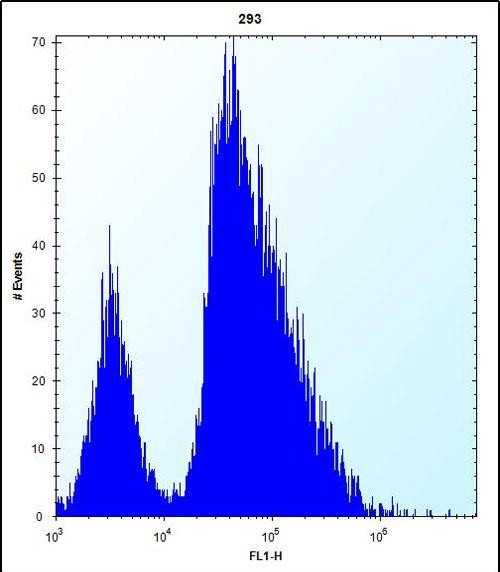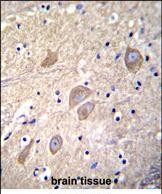



| WB | 1/1000 | Human,Mouse,Rat |
| IF | 咨询技术 | Human,Mouse,Rat |
| IHC | 1/100-1/500 | Human,Mouse,Rat |
| ICC | 技术咨询 | Human,Mouse,Rat |
| FCM | 1/10-1/50 | Human,Mouse,Rat |
| Elisa | 咨询技术 | Human,Mouse,Rat |
| Aliases | Visinin-like protein 1, VILIP, VLP-1, Hippocalcin-like protein 3, HLP3, VSNL1, VISL1 |
| Entrez GeneID | 7447 |
| WB Predicted band size | 22.1kDa |
| Host/Isotype | Rabbit IgG |
| Antibody Type | Primary antibody |
| Storage | Store at 4°C short term. Aliquot and store at -20°C long term. Avoid freeze/thaw cycles. |
| Species Reactivity | Human, Mouse |
| Immunogen | This VSNL1 antibody is generated from rabbits immunized with a KLH conjugated synthetic peptide between 47-75 amino acids from the Central region of human VSNL1. |
| Formulation | Purified antibody in PBS with 0.05% sodium azide. |
+ +
以下是关于VSNL1抗体的3篇参考文献及其摘要内容概括:
---
1. **文献名称**: "Visinin-like protein 1 (VSNL1) is a novel biomarker for Alzheimer's disease"
**作者**: Tarawneh R, et al.
**摘要**: 该研究通过免疫印迹和免疫组化方法验证了VSNL1抗体在脑脊液和脑组织中的特异性,发现VSNL1表达水平与阿尔茨海默病病理进展相关,提示其作为潜在生物标志物的价值。
---
2. **文献名称**: "Development and characterization of a monoclonal antibody specific for human VSNL1"
**作者**: Kim H, et al.
**摘要**: 研究团队开发了一种高特异性的抗人VSNL1单克隆抗体,通过ELISA、Western blot和免疫荧光实验验证其灵敏度与交叉反应性,确认其在神经细胞系和肿瘤组织中的检测适用性。
---
3. **文献名称**: "VSNL1 promotes cancer metastasis through the NF-κB pathway and is a therapeutic target in hepatocellular carcinoma"
**作者**: Zhang Y, et al.
**摘要**: 利用VSNL1抗体分析肝癌组织中蛋白表达,发现VSNL1通过激活NF-κB通路促进肿瘤转移,抗体检测结果支持其作为肝癌预后标志物及治疗靶点的潜力。
---
如需更多文献,建议通过PubMed或Google Scholar以关键词“VSNL1 antibody”或“VSNL1 immunodetection”检索近年研究。
VSNL1 (Visinin-like protein 1), also known as VILIP-1. is a calcium sensor protein belonging to the neuronal calcium sensor (NCS) family. It regulates intracellular calcium signaling and is predominantly expressed in the central nervous system, particularly in neurons, where it modulates synaptic plasticity, neurotransmitter release, and neuronal survival. Dysregulation of VSNL1 has been implicated in neurodegenerative disorders, including Alzheimer’s disease (AD), as it interacts with amyloid-beta (Aβ) and tau pathology, potentially serving as a cerebrospinal fluid biomarker for early AD diagnosis.
Antibodies targeting VSNL1 are essential tools for studying its expression, localization, and function in both physiological and pathological contexts. These antibodies enable detection via techniques like Western blotting, immunohistochemistry (IHC), and immunofluorescence (IF). Researchers utilize VSNL1 antibodies to explore its role in cancer as well, where its overexpression in certain tumors correlates with metastasis and poor prognosis. Commercially available VSNL1 antibodies are typically raised in hosts such as rabbits or mice, with validated specificity through knockout controls or peptide blocking assays. Their applications span basic research, diagnostic development, and therapeutic target validation, emphasizing VSNL1's dual role as a biomarker and a mediator of disease mechanisms.
×